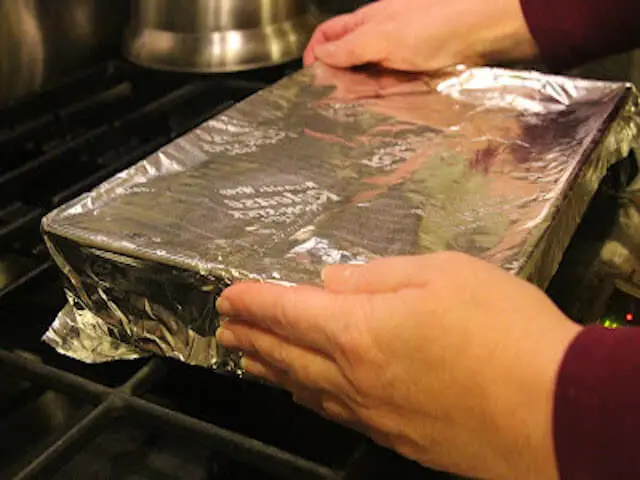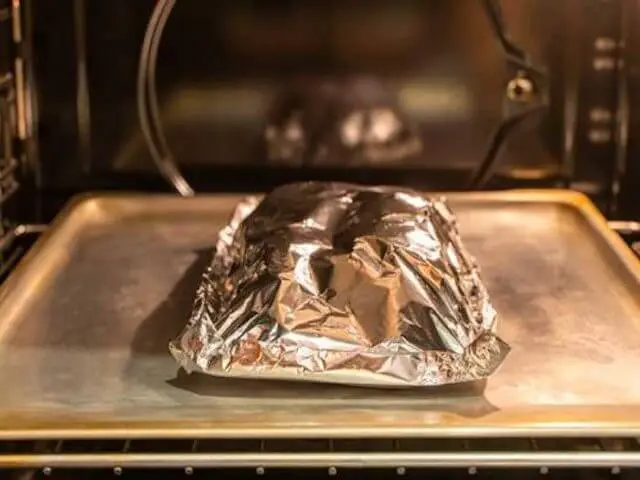Microwaves are like culinary superheroes in our kitchens. They save us time, reheat leftovers in a flash, and make cooking a breeze which is perfect for busy people like you. But when it comes to putting aluminum foil in your microwave, questions about safety often come to mind especially when there is a common idea that it can cause sparks to fly when heated.
To help you be informed, here is the science of microwaves and the properties of aluminum foil to answer some of your questions.
Read here to find out about microwaving ziploc bags.
How Do Microwaves Work?
Microwaves are masters of electromagnetic radiation. They send out waves in the microwave frequency range, typically around 2.45 gigahertz. These waves significantly affect the water, fats, and other molecules found in your food.
When these molecules absorb the waves, they start to vibrate and this will eventually generate heat which causes your meals to cook within a couple of minutes.
In simple terms, a microwave oven controls water molecules that kick-start the cooking of your food from the inside out.
What is Aluminum Foil?
Now, let’s talk about the nature and properties of aluminum foil. We use it in our kitchens for all sorts of culinary adventures such as wrapping food, covering dishes, and even assisting in certain cooking methods. It comes in foil trays, tin foil, and other microwave-safe containers to keep your meals properly sealed and secured for cooking purposes.
Aluminum foil has the ability to conduct heat and electricity. This means it spreads the heat around evenly, making it a go-to for various cooking applications depending on the duration and degree of heat that you set in your cooking method.
Is it Safe to Microwave Aluminum Foil?
Yes, it is safe to microwave small pieces of aluminum foil. Plain, old aluminum foil can cause sparks and even pose a risk to your microwave. These sparks happen because the foil reflects the microwave radiation, potentially leading to an electric current when heating food.
When your food is completely wrapped in aluminum foil, it could damage your microwave or, in extreme cases, create a fire hazard that can be detrimental to your safety. That is why it is important to understand that only smaller sizes of aluminum foil covering a portion of your food are safe for heating in microwave ovens.
What Happens to Aluminum Foil in the Microwave?
When you pop plain aluminum foil into the microwave, it acts as a barrier to microwave radiation. It produces electric currents that start flowing through the foil which causes sparks.
This is a common problem in the kitchen when people are not aware if the foil is microwave-safe or not. Hence, it will be a great help if you know more about some safety tips for using Aluminum foil in the microwave.
How to Safely Use Aluminum Foil in the Microwave?
Here are some tips on how you can properly handle an aluminum foil in the microwave:
- Use only small pieces of aluminum foil: It is recommended that you only use small pieces of aluminum foil to cover some areas in your food to prevent it from being overcooked.
- Keep it flat and avoid using wrinkled aluminum foil: Make sure your foil is flat and covers your food without any wrinkles or folds. Any unevenness can increase the risk of sparks flying. Brand-new smooth foil is the best option for your cooking needs.
- Leave space: Give your foil-wrapped food some breathing room by leaving at least an inch of space between the foil and the oven walls or other food items.
- Avoid sharp edges: Fold the foil’s edges neatly to eliminate any pointy areas that could spark and come in contact with a heavy metal pan.
Can I Eat Food That Has Been Microwaved with Foil?
Yes, small pieces of aluminum foil are designed to withstand the microwave’s radiation without causing any safety issues. If there are any unusual changes or damage to the foil, it’s best to exercise caution and consider not consuming the affected portion.
If your oven has metal shelves or comes with a metal turntable, remember not to microwave food using metal pans, especially aluminum foil. Also, don’t let foil shielding touch or be close to the turntable to prevent any safety hazards for you and your family.
What Other Substitutes Can You Use in the Microwave Instead of Aluminum Foil?
Silicone baking sheet
A silicone baking mat or silicone liner is a great alternative to aluminum foil. It’s heat-resistant, non-stick, and safe for use in the microwave. You can place it on the microwave turntable or under the food you’re heating.
Plastic wrap
This is a convenient choice for covering food in the microwave that helps in trapping steam and moisture which is useful when reheating items like vegetables. Be sure to use microwave-safe plastic wrap to prevent it from melting or releasing harmful chemicals. We do not want our food to be contaminated.
Parchment paper
Parchment paper is another microwave-safe option. It’s useful for wrapping foods that you want to keep moist, like fish or chicken. Also, a good choice to prevent splatters and make cleanup easier.
You should always opt for a microwave-safe container and only aluminum foil in smaller pieces are safe for heating using microwave ovens.
Why Can’t You Put Aluminum Foil in the Microwave But Allowed in the Oven?
Microwaves work by emitting electromagnetic waves that excite water molecules in food, causing them to vibrate and generate heat.
When you place regular aluminum foil in a microwave, it can reflect these waves and cause electric currents to flow through the foil. Microwaves emit a particular type of waves that are in between radio waves and infrared radiation.
On the other hand, ovens operate by means of heating the air inside which will cause your food to start cooking. You can safely use the foil in wrapping or covering your food to protect it from direct heat and avoid burning it.
You Can Microwave Aluminum Foil
So there you have it, the basics of using an aluminum foil in your microwave ovens at home.
Remember the tips mentioned whenever you are planning to use it to help you maximize its benefits and convenience without any safety concerns. These will also help elevate and make your meal preparation more safe and exciting. Happy cooking!
Is tupperware microwave safe? Read here now.














